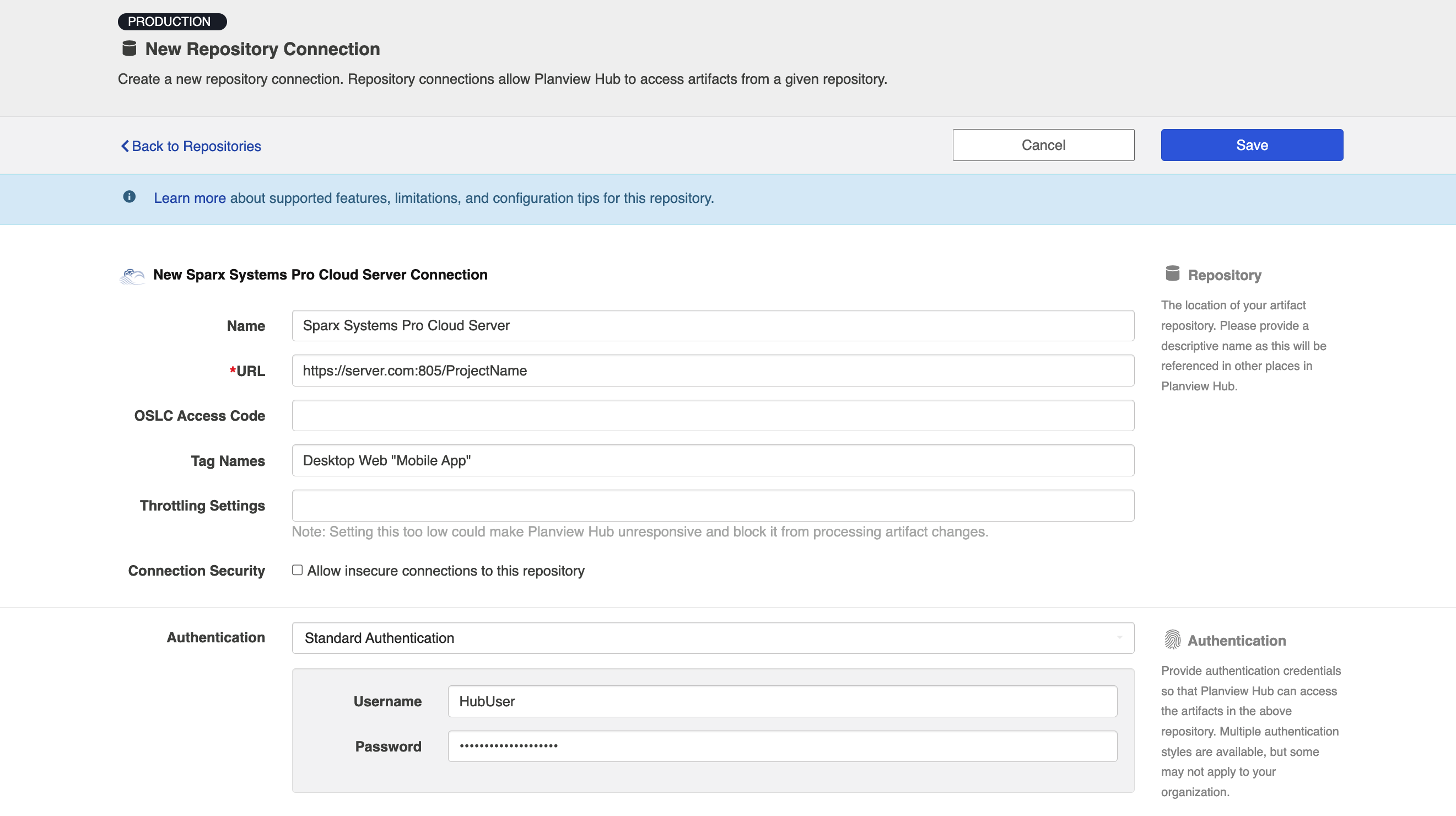Sparx Systems Pro Cloud Server
- Last updated
- Save as PDF

Overview
Models are a terrific way to communicate structure, behavior, and interactions. By creating them during requirements elicitation, one can communicate concepts that can be very difficult to convey using text alone.
Integrating Sparx Enterprise Architect with requirements management, agile planning, and test management tools via Planview Hub’s Sparx Pro Cloud Server connector creates a fully end-to-end traceable and measurable software development process. Practitioners can collaborate on artifacts each from within their tool of choice, with data and handoffs flowing seamlessly between them.
Here’s an example scenario of using Sparx EA in an integrated IT toolchain:
- A business analyst performs the analysis and creates business process models in Sparx EA, refines the model into a set of requirements and creates traces among the requirements
- Hub, via Sparx Pro Cloud Server, mirrors those requirements (and their relationships) into a requirements management tool such as Jama or DOORS
- A business analyst would then use the requirements management tool to continue to refine the design and oversee their development
- Hub replicates the requirements into an Agile planning tool and a test management tool, enabling developers and testers the ability to develop and test in their tool of choice
Key Features and Benefits
- Via Sparx Pro Cloud Server, Hub synchronizes requirements in Sparx EA to other requirements management, Agile planning, test management, or other tool of choice, allowing information to flow freely.
- Hub improves collaboration by allowing business analysts to use the tool most appropriate for the job, while enabling developers, testers, and other teams to receive work in their tool of choice .
- Hub enables traceability between models and requirements in Sparx EA and other artifacts in SDLC tools.
Common Integration Patterns
Demo Videos
Supported Extensions
Sparx Systems Enterprise Architect (Sparx EA)
The Sparx Pro Cloud Server connector allows users to access artifacts within Sparx Systems Enterprise Architect (Sparx EA). Users must have both Sparx EA and Sparx Pro Cloud Server in order to synchronize artifacts using Planview Hub. When configuring your Repository Connection in Hub, you will connect using your Sparx EA credentials.
Supported Editions
Planview Hub only provides support for ‘Premium Editions’ of Sparx Systems Pro Cloud Server that allow unlimited tokens. Token Editions are not supported.
Connector Setup Details
This section describes the basic steps needed to prepare your Sparx Pro Cloud Server instance for use with Hub. Note that additional fields for synchronization or configuration of queries may be required depending on the requirements of your integration.
Minimal User Permissions & Hub User
We recommend that you create a new user within your external tool, to be used only for your Hub integration. This is the user information you will enter when setting up your repository connection within Planview Hub. By creating a new user, you will ensure that the correct permissions are granted, and allow for traceability of the modifications that are made by the synchronization.
In general, your user account should have sufficient permissions to create, read, and update artifacts in your repository. However, depending on the use case, your user may need different permissions. For example, if you are only interested in flowing data out of your repository, your user may not need to have full CRUD access, as the 'create' and 'update' permissions may not be needed.
Your user should have a secure password or token. Please be aware that Hub will not allow you to save a repository connection utilizing a weak password/token, such as 'tasktop.'
To use the Sparx Systems Pro Cloud Server connector, your Hub user should have the following permission set:
- Update Elements
Connecting to the Sparx Systems Pro Cloud Server Repository
Standard Authentication
Required Fields:
- Location/Connection URL for Sparx EA, with project name appended
- Example Format: https://server.com:805/ProjectName
- Username for Sparx EA
- Password for Sparx EA
Optional Fields:
- OSLC Access Code
- Only required if the project is configured to require an OSLC Access Code.
- Tag Names
- Names of tags to be made available as fields for integration. Names must be separated by spaces, and names with spaces in them must be surrounded by double quotes.
- Throttling Settings: This field indicates the number of API calls that can be made per minute. See details here.
- Note: This field should only be set under the guidance of customer care as the ideal value is highly dependent on each customer's unique environment.
- Connection Security: If checked, insecure connections to this repository will be allowed. See details here.

SSO Authentication
Additionally, Sparx Systems Pro Cloud supports the following SSO implementations:
- Script (HTTP cookies)
- X.509 Certificate
Learn more about how to set up your repository in Planview Hub here.
Tags
If tags are to be included in integrations, use the Tag Names field in the repository to specify the names of tags to be used. Tag names that have spaces must be surrounded by double quotes, and tag names must be specified by spaces. For example:
Grape "Wine Advisor Rating"
Specifies two tag names.
Tag names are dynamically made into String fields on the artifact schema. If tag names are changed, a schema refresh is triggered, and collection mappings will need to be updated based on changes.
Note: Tags with a specified tagged value type are not supported.
Other Configuration Settings
Full Scan
Due to third party API limitations, updates to the following fields may not trigger change detection or cause a synchronization immediately. To ensure these updates synchronize, a high fidelity full scan must occur or another qualifying change must be made to the artifact:
- Comments
- Relationships (Multi-Links)
- Tags
Learn more about how to configure change detection and full scan intervals in Planview Hub here.
Supported Features
Special Features Supported
You can learn more about special features in Planview Hub here.
|
Feature |
Custom Type Supported? |
Applicable Hub Versions |
Applicable Repository Versions |
|---|---|---|---|
|
|
|
|
|
|
|
N/A |
Planview Hub: 18.1 and later |
Any supported repository version: |
|
|
|
|
|
|
N/A - State Transitions (Sparx Systems Pro Cloud Server does not use state transitions. Status can flow out of or into Sparx Systems Pro Cloud Server as a single-select.) |
N/A |
Planview Hub: 18.1 and later |
Any supported repository version: |
|
|
|
|
|
Supported Artifacts
Supported Work Items
Learn about the difference between containers and work items in Planview Hub here.
|
Supported Work Item Type |
Applicable Hub Versions |
Applicable Repository Versions |
Unique URL? |
|---|---|---|---|
|
Requirement |
Planview Hub: 18.1 and later |
Any supported repository version: |
No |
|
Use Case |
Planview Hub: 18.1 and later |
Any supported repository version: |
No |
|
Actor |
Planview Hub: 18.1 and later |
Any supported repository version: |
No |
|
Class |
Planview Hub: 20.3 and later |
Any supported repository version: |
No |
|
Component |
Planview Hub: 22.4 and later |
Any supported repository version: |
No |
|
Interface |
Planview Hub: 22.4 and later |
Any supported repository version: |
No |
|
Diagram |
Planview Hub: 23.2 and later |
Any supported repository version: |
No |
Supported Containers
Learn more about containment in Planview Hub here.
|
Containers that can synchronize between repositories |
Applicable Hub Versions |
Applicable Repository Versions |
Unique URL? |
|---|---|---|---|
|
Packages Note: Beginning in Hub version 22.4, containers can be treated as work items. Learn more here. |
Planview Hub: 18.1 and later |
Any supported repository version: |
No |
|
Containers used to define the boundary of a collection (When clicking 'Manage Projects' on a Collection) |
|
|
|
|
N/A (entire repository serves as container) |
Planview Hub: 18.1 and later |
Any supported repository version: |
N/A |
|
Containers used for artifact routing |
|
|
|
|
Packages |
Planview Hub: 18.1 and later |
Any supported repository version: |
N/A |
Supported Field Types
Note: If one field of a given type is supported, others that are also that type in theory should also work. However, sometimes there are instances in which this is not the case due to the repository. So, while we can claim support for fields at the type level, there is a chance that some specific fields of a given type will not synchronize properly.
|
Standard Field Type |
Does Hub support custom fields of this type? |
How is field type referenced in the repository? |
Sample Repository Fields Supported |
Particular Repository Fields NOT Supported |
|---|---|---|---|---|
|
|
|
String |
Subject Alias Creator |
|
|
|
|
Drop-Down List |
Status |
Difficulty Priority Stability |
|
|
|
|
|
|
|
|
|
|
|
|
|
|
|
|
|
|
|
|
|
Date Time |
Created Modified |
|
|
|
|
|
|
|
|
|
|
|
|
|
|
|
|
|
|
|
|
|
|
|
|
|
|
|
|
|
|
|
|
Learn how to configure relationships in Planview Hub here. |
|
Links |
Hierarchy (only writeable on artifact creation) Resource links (read-only) |
|
|
|
|
Description |
Description |
|
|
|
|
|
|
|
|
|
|
Tags |
Tags |
|
Functional Limitations
|
Category |
Limitation |
Applicable Hub Versions |
Applicable Repository Versions |
|---|---|---|---|
|
Configuration Requirement |
Diagram Images Automatic Viewable Components must be configured to synchronize Diagram images through the "Diagram" rich text field. Learn more here. |
Planview Hub: 23.2 and later |
Any supported repository version: |
|
Third Party API Limitation |
Diagrams The Diagram artifact type is read-only. |
Planview Hub: 23.2 and later |
Any supported repository version: |
|
Feature Not Supported |
Tags Tags with a specified tagged value type are not supported. |
Planview Hub: 18.1 and later |
Any supported repository version: |
|
Third Party Functional Limitation |
Projects Because Sparx Pro Cloud Server does not support the notion of ‘projects,' the following behaviors may be observed when using Hub:
|
Planview Hub: 18.1 and later |
Any supported repository version: |
|
Third Party API Limitation |
Scalability When flowing a large number of artifacts (i.e., 10,000) from Sparx, socket timeouts can occur. To resolve this, set the com.tasktop.artifacts.rest.RestClient.socketTimeout system property to a higher value (such as 30 minutes). In Windows, this can be set by running 'Manage Tasktop,' and updating the Java Options on the Java tab. |
Planview Hub: 18.1 and later |
Any supported repository version: |
|
Third Party API Limitation |
Attachments Attachments are not supported. |
Planview Hub: 18.1 and later |
Any supported repository version: |
|
Third Party API Limitation |
Date Fields Sparx Pro Cloud Server does not return time zone information for dates, so users may need to use a Hub extension to adjust date fields to their timezone. |
Planview Hub: 18.1 and later |
Any supported repository version: |
|
Third Party API Limitation |
Comments Sparx Pro Cloud Server does not support sub-second comment creation times. As a result, comments posted in the same second might not be returned in the order posted. |
Planview Hub: 18.1 and later |
Any supported repository version: |
|
Third Party API Limitation |
Tags Tags cannot be deleted. |
Planview Hub: 18.1 and later |
Any supported repository version: |
|
Configuration Requirement |
Tags Only tags that are added to the Repository field "Tag Names" will be available for mappings. |
Planview Hub: 18.1 and later |
Any supported repository version: |
|
Configuration Requirement |
Packages If a containment synchronization of Packages is set up, new Packages must have another Package as their parent artifact (not Model Root) |
Planview Hub: 18.1 and later |
Any supported repository version: |
|
Configuration Requirement |
Tags Duplicate tags are not supported. When there are multiple tags with the same name, only the value of the first tag is retrieved. When attempting to update the value of a tag for a Pro Cloud Server resource having multiple tags with the same name, an exception will be thrown by the connector. For example, if a resource has three tags named "A", "B" and "B", updates to values for "A" will be accepted, but updating the value of "B" will cause an error. |
Planview Hub: 18.1 and later |
Any supported repository version: |


 Time Worked (Worklogs)
Time Worked (Worklogs)